|
Thread Number: 16876
Early Mechanical Dishwashing |
[Down to Last] |
Post# 278291 5/4/2008 at 19:08 (5,828 days old) by unimatic1140  (Minneapolis) (Minneapolis) |
||

I recently found some new information on the Walker Dishwasher Company that I thought was very cool and wanted to share this with the club. As some of you might know the Walker Dishwasher was the very first successful home dishwasher in the US. In 1930 the Walker Dishwasher Company was bought out by General Electric, so the Walker dishwasher was the predecessor to the GE dishwashers. But first lets go way back and show you all what I found on early dishwashing machines. The earliest dishwashing machine patent I can find was this one by a Mr. Joel Houghton of Ogden, NY. Patent #7365 was issued in 1850. The title of the patent is "Improvement in Machines for Washing Table Furniture". Of course the word "Improvement" obviously means dishwashing machines were around even earlier, but I have yet to find any dishwasher patents earlier than this one. His machine was cylindrical in shape and made use of a paddle wheel to throw the water through a side opening onto the dishes. As the operator turned the crank to throw the water against the dishes, the round dishrack would also slowly rotate. Interesting that we see the "Roto-Rack" design as early as 1850. 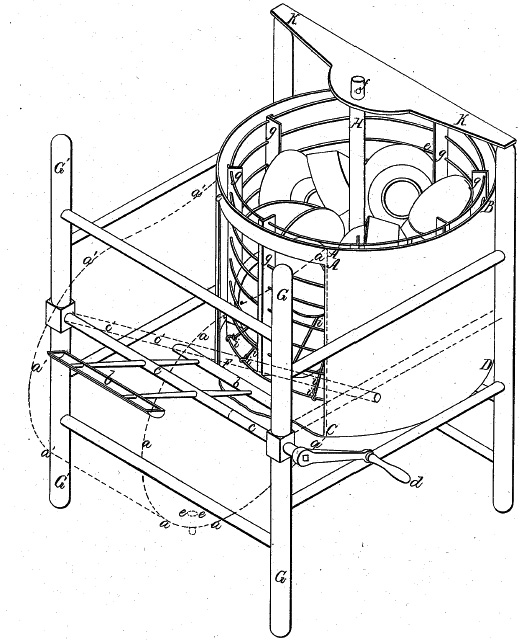 In 1863 I found the first patent for an Impeller style dishwasher, Patent #40280. The patentees describe their machine as follows, "we are aware that machines have been made for washing dishes and other table furniture, and that the wash-washer has been thrown against the dishes by a revolving wheel, which acted in a chamber separate from that in which the dishes were placed and washed. These things we do not claim in our patent as they have failed from their bulkiness and impracticability as a useful household implement to go into general use. Our object has been to devise a neat, compact, efficient and cheap machine for washing dishes". So it appears that this is the first patented dishwasher where the impeller and dishes reside in the same tank. Notice not only does this machine have an impeller and basket for holding dishes, it also has a small side chamber with sponges to scrub hard to clean dishes. 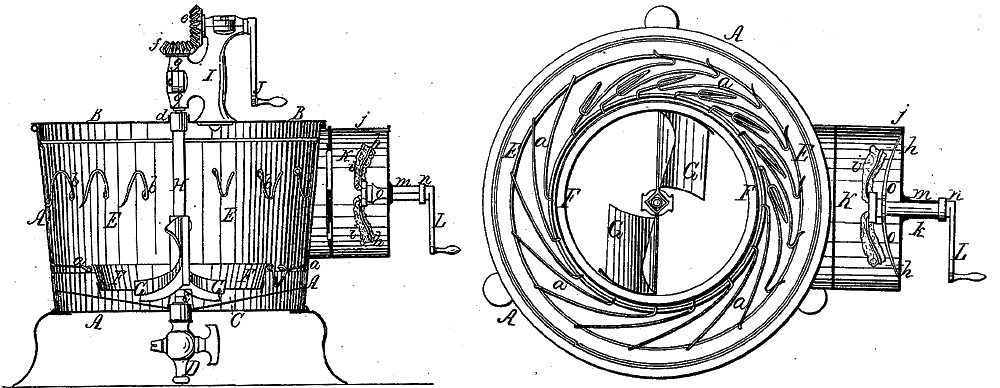 Onto the 1880's and a big yay for the fact that men were not the only ones who were working on eliminating this three times a day chore. In the 1880's an imaginative and purposeful lady, Mrs. Josephine Garis Cochrane, built a machine to do her own dishes. The story seems to go that she was sick and tired of her servants breaking her fine china, so she decided to come up with a better way to wash her dishes. Her design lent itself to larger chores and was soon in demand for dishwashing in restaurants. In fact, at the time of the Columbian Exposition in Chicago in 1893, her products were so well received that she sold all of the machines used in the concessions at the World's Fair - a total of nine dishwashers. If you google Josephine Cochrane you will see that most websites claim that she invented the dishwasher, but its obvious from patents searches that dishwashers had been around for at least 30 years before that. Josephine began to market her dishwasher to restaurants under the trade name of Garis-Cochran Dish-Washing Machine Company which eventually was changed to the Crescent Washing Machine Company. In 1911 Crescent had developed its first "small" dishwasher made for home use (shown below). It appears from the patents that Josephine's dishwashers never used impellers to wash the dishes but used modern style jet-spray arms! The Crescent Company lasted until 1926 when they were bought out by Hobart who of course started producing the KitchenAid. So it could be said that Josephine's dishwasher was the forerunner of the modern KitchenAid brand as well as every other dishwasher made today. For more interesting information on Josephine, do google her name. 1911 Home Model: 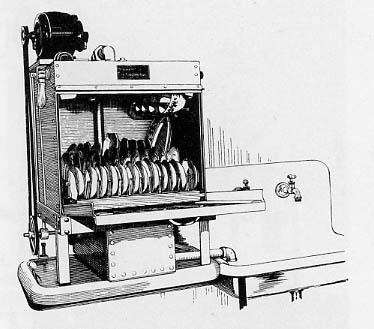 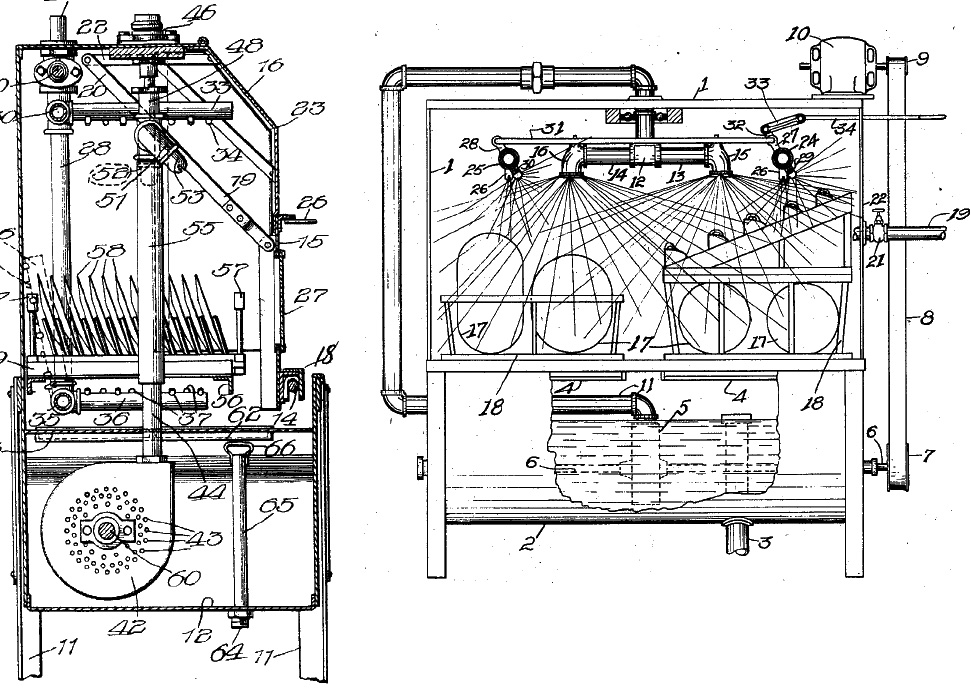 In 1909 the Walker brothers of Syracuse, NY who owned a hardware store applied for and received a patent for a new dishwashing machine. They had printed some postcards which they sent out to some prospective customers to see if anyone would be interested in buying their machines. The response was so good thanks to the illustration on the card showing a lady operating the machine that they decided to manufacture the machines in the rear of their store. The 1911 model shown below included a pulley and a belt so the machine could be operated "automatically" by means of a gasoline engine. Of course like the earlier dishwashers the machine still need to filled with water and emptied by hand. 1911 Walker: 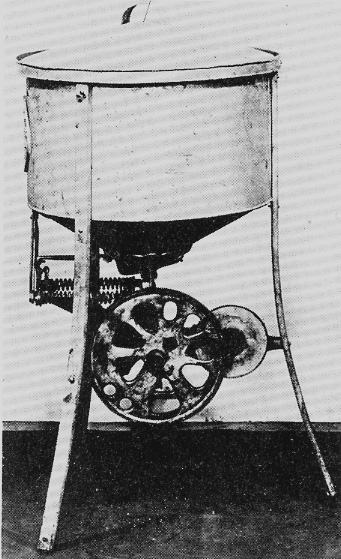 In 1913 when the Walker Brothers hardware store was wired for electricity they produced thier first electric dishwasher. It sold for $120 as compared to the $20.00 hand crank model. Following World War I, the Walker dishwasher took on a new look. The tub was smoothed out and painted and the legs were shaped to harmonize with the age of short skirts. The building boom of the early 1920's stimulated the design of a Dishwasher-Sink combo which drew the attention of the builders of the day. Up until 1927 the Walker Dishwasher was a gear drive machine when they introduced their first direct drive model. 1918 Walker: 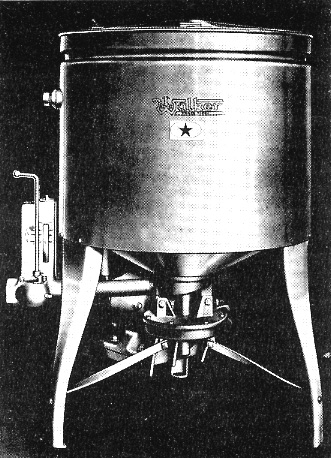 1924 Walker:  1927 Walker (1st Direct Drive Model): 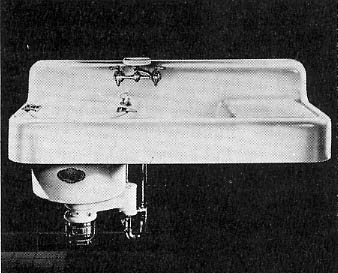 In 1930 GE had acquired the Walker Brothers Company and moved the dishwasher production to the Hotpoint factory in Chicago. The first General Electric branded dishwasher was produced in 1932. It had a square tub, a single control handle, rubber coated steel dish racks and the first automatic water level measuring valve. The free standing unit had a front panel which served as a shelf when raised. 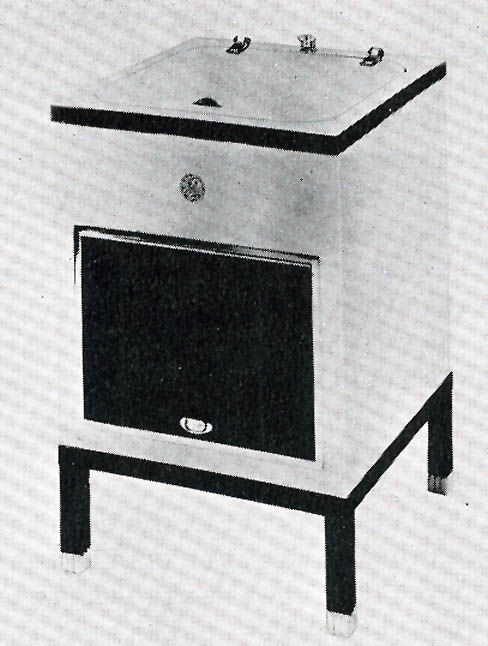 | ||

|
Post# 278295 , Reply# 1 5/4/2008 at 19:12 (5,828 days old) by unimatic1140  (Minneapolis) (Minneapolis) |
||
 | ||
Post# 278297 , Reply# 2 5/4/2008 at 19:14 (5,828 days old) by unimatic1140  (Minneapolis) (Minneapolis) |
||
 | ||
| Post# 278326 , Reply# 3 5/4/2008 at 20:11 (5,828 days old) by maytagbear (N.E. Ohio) | ||
|
Facinating! Thank you, Robert, for posting this!! Lawrence/Maytagbear | ||
| Post# 278329 , Reply# 4 5/4/2008 at 20:18 (5,828 days old) by cehalstead (Charleston, WV) | ||
|
wonderful thread ...what a wonderful thread! | ||
Post# 278333 , Reply# 5 5/4/2008 at 20:45 (5,828 days old) by gansky1  (Omaha, The Home of the TV Dinner!) (Omaha, The Home of the TV Dinner!) |
||
 | ||
Post# 278334 , Reply# 6 5/4/2008 at 20:47 (5,828 days old) by bajaespuma  (Connecticut) (Connecticut) |
||
This was great!
Nifty. Makes me want a dishwasher sink now, but, since I work in a restaurant, basically I have one I can use every day, it's just all made out of stainless steel. But there's something wonderful about those porcelain kitchen sink DW models. We moved into a house once when I was barely 6 years old that had a dishwasher-sink. It had a large and tall impeller that was black bakelite and I remember thinking that the thing was a clothes washing machine because the racks were missing, as I recall. | ||
| Post# 278363 , Reply# 7 5/4/2008 at 22:28 (5,828 days old) by tlee618 () | ||
|
Robert that was so interesting, thanks so much for sharing it. Didn't GE have a round dishwasher at some point? | ||
| Post# 278376 , Reply# 8 5/4/2008 at 23:58 (5,828 days old) by tuthill () | ||
|
tlee618 Yes, they did. I don't know anything about them, but here's a couple of pictures. CLICK HERE TO GO TO tuthill's LINK | ||
| Post# 278386 , Reply# 9 5/5/2008 at 03:21 (5,827 days old) by sudsman () | ||
|
Wow Very Kool. Love history | ||
Post# 278388 , Reply# 10 5/5/2008 at 05:35 (5,827 days old) by gyrafoam  (Wytheville, VA) (Wytheville, VA) |
||
|
Very interesting! Especially nice to get some information on KAid's early history. Thank you for passing along this information! | ||
| Post# 278394 , Reply# 11 5/5/2008 at 07:21 (5,827 days old) by tlee618 () | ||
|
Thanks for the information Jed! | ||
| Post# 278398 , Reply# 12 5/5/2008 at 07:38 (5,827 days old) by westyslantfront () | ||
|
Hi Robert. Thank you for posting these fascinating pictures. I really enjoying seeing the pictures of the very early dishwasher/sink combination. Ross | ||
| Post# 278408 , Reply# 13 5/5/2008 at 10:15 (5,827 days old) by peterh770 (Marietta, GA) | ||
 | ||
| Post# 278457 , Reply# 16 5/5/2008 at 13:57 (5,827 days old) by rolls_rapide (.) | ||
|
Walker Dishwasher Didn't Miele have a similar design of dishwasher? | ||
Post# 278533 , Reply# 18 5/5/2008 at 21:06 (5,827 days old) by jetcone  (Schenectady-Home of Calrods,Monitor Tops,Toroid Transformers) (Schenectady-Home of Calrods,Monitor Tops,Toroid Transformers) |
||
Thats interesting about Josephine
I wonder if she got to no broken dishes with her servants? I saw a restored 1918 Hobart commercial machine at the last restaurant show and it had the spray arm in solid copper mounted under the Spruce dishrack! In fact the entire machine cabinet was made out of copper sheet and it had the same lift door mechanism commercial Hobart machines use today! So Josephine may not have been the first with a spray arm but her machine must have had some elements Hobart figured it needed. You go Josephine! | ||
| Post# 278750 , Reply# 22 5/6/2008 at 20:30 (5,826 days old) by toploader55 (Massachusetts Sand Bar, Cape Cod) | ||
Great Thread...Josephine Cocharane
I've been in the restaurant biz for 39 years. Followed it all. The best machine ever was the XM Model series. Built like tanks, Best spray patterns ever, One pass, and the racks came out spotless. Single Tank mind you. They had the Hobart Cresent "Dual Drive" to convey the racks through the spray pattern, but also had a dwell bar. The Dwell bar would let a rack sit in the spray pattern until the next rack was pushed in. If you wanted the rack to continue, there was a lever in the front of the machine that you pushed down which released the "pawls" of the conveyor system until it caught on the last of the "pawls" . Which were made of "Ni Resist" (Cast Iron". Stationary lower wash arm, And a 3-arm revolving upper wash arm. The rinse arms have remained the same after 40 some odd years.Always offering the lowest Rinse consumption. Every commercial Dish Machine has always followed Hobart. The XM series will truley remain an Icon in the Commercial Dish Machine series. (Right stevet ????????) By the way, The upper spray arms were of an external ball bearing mount. Early XMs had them exposed, so you could see if they were turning or not. Then later they were hidden by the Temperature Mounts.The C-series. The best feature of the XM series was they had a like a 3x5 port hole window on the inspection door which you could watch the spray pattern. Wicked cool and awsome machine.Truely with out a doubt "Tanks of steel".
| ||
| Post# 278795 , Reply# 24 5/7/2008 at 01:10 (5,826 days old) by maytagbear (N.E. Ohio) | ||
|
What about the Jackson? I know of two churches here in the region who have Jackson brand dish machines. Cool looking things, but they are round, and don't seem very efficient with space. Lawrence/Maytagbear | ||
| Post# 278799 , Reply# 25 5/7/2008 at 04:12 (5,825 days old) by toploader55 (Massachusetts Sand Bar, Cape Cod) | ||
Jacksons
Like all commercial machines, Jackson seemed to have it's "HayDay", when they produced the round machine. Jackson for some reason seemed very popular in Chinese Restaurants years ago. They were made well and were less money than Hobart. One thing,they had a little tiny mesh screen in the sump that used to clog with food fiber after about 18-20 racks passed through thus effecting the pump pressure. They would clog so much that you could open the hood or door while they were running, and watch the water trickle out of the spray jets. A pain in the butt to clean, I use to take a pair of tongs and hold the filter over a gas burner on the range and burn the filter clean.
| ||
Post# 278878 , Reply# 29 5/7/2008 at 18:17 (5,825 days old) by petek  (Ontari ari ari O ) (Ontari ari ari O ) |
||
 | ||
| Post# 278881 , Reply# 30 5/7/2008 at 18:56 (5,825 days old) by toploader55 (Massachusetts Sand Bar, Cape Cod) | ||
Wow Colt Auto San
Holy S--T, Does that bring back memories. I had totally forgot about them. When did they go out of business ? I remember seeing a few of those as a child. But Tom...You are absolutely right. Hobart did say and there are no more true words..."Either the dishes have to move or the water has to move". My Dad's restaurant had a Insinger "Ensign". A 16x16 rack, stationary spray tubes and was a roll top model similar to the Hobart LM and SM models. The Hobart Rolltops had a revolving lower wash arm where as the Insinger had stationary spray tubes. The results : Horrible on the Insinger that is. I used to love to go to the used restaurant equipment warehouses and see all those Mammoth Hunks of Stainless Steel waiting for either a new home or just waiting there destiny. Blakeslee wan't too bad of a machine. Their "Sani Stream Spray Boxes" were some what of a disappointment though. I do believe that Insinger now has an exclusive with the U.S. Navy and builds all their machines for ships and aircraft carriers. I was at their Web Page last year. I'm still not too impressed with the design. One of our service techs for the restaurant highly recommended them though. What are your thoughts on Insinger and Colt Autosan stevet ???????? | ||
| Post# 278890 , Reply# 31 5/7/2008 at 19:45 (5,825 days old) by bestcleaning () | ||
|
Oh My. Dishwasher 1911? Very cool. Thank you for posting this. | ||
| Post# 279189 , Reply# 34 5/9/2008 at 19:29 (5,823 days old) by duetboy () | ||
|
I'm sure you've all seen this on you tube but I thought I'd post it here, too! It's a Hobart dishwasher at a show. They've put in a clear plastic panel to show it's wash action. Watch out tupperware! Jeff CLICK HERE TO GO TO duetboy's LINK | ||
| Post# 279307 , Reply# 35 5/10/2008 at 19:34 (5,822 days old) by toploader55 (Massachusetts Sand Bar, Cape Cod) | ||
Meiko at Work
I'll post a few pics of the commercial machine at my job. It's a Meiko. Sort of new around here. Made in Germany, not too reliable(considering it comes from the land of BMW and Daimler Benz). Note the I, II, III pads. I is Short Wash,II is Normal Wash, and III is "Intensive Wash". I is about 60 seconds. II is about 120 seconds, and III is roughly 4 minute wash. All cycles depend if the final rinse booster and tank are at specified Temperatures.

| ||
| Post# 279309 , Reply# 36 5/10/2008 at 19:37 (5,822 days old) by toploader55 (Massachusetts Sand Bar, Cape Cod) | ||
Second Shot | ||
| Post# 279310 , Reply# 37 5/10/2008 at 19:39 (5,822 days old) by toploader55 (Massachusetts Sand Bar, Cape Cod) | ||
Up Shot | ||
Post# 279317 , Reply# 38 5/10/2008 at 20:57 (5,822 days old) by tomturbomatic  (Beltsville, MD) (Beltsville, MD) |
||
|
Seems like having the wash chamber raise like that lets a lot more heat escape than just having doors on two sides, but what do I know? | ||
| Post# 279360 , Reply# 39 5/11/2008 at 02:44 (5,821 days old) by toploader55 (Massachusetts Sand Bar, Cape Cod) | ||
You're 100% right Tom
As I said, the machine cleans well. But is horrible in design. Our machine is 3 years old and we've already replaced the Rinse Pump, Drain Pump,fill solenoid,2 Main Circuit Boards,and a Start Switch. I am always walking by the machine closing the door to keep the heat in. The owner said she chose that machine because a Hobart wouldn't fit in the space. I told her she got bamboozled because there used to be a Hobart there. And they're all pretty much the same size for replacement reasons.As a tech told me many years ago when they started to incorporate circuit boards into Commercial Dishmachines "This is nothing but trouble. This kind of electricity and water just don't mix".
| ||
| Post# 280295 , Reply# 40 5/15/2008 at 19:21 (5,817 days old) by toploader55 (Massachusetts Sand Bar, Cape Cod) | ||
Hey STEVE | ||

 Comes to the Rescue!
Comes to the Rescue!